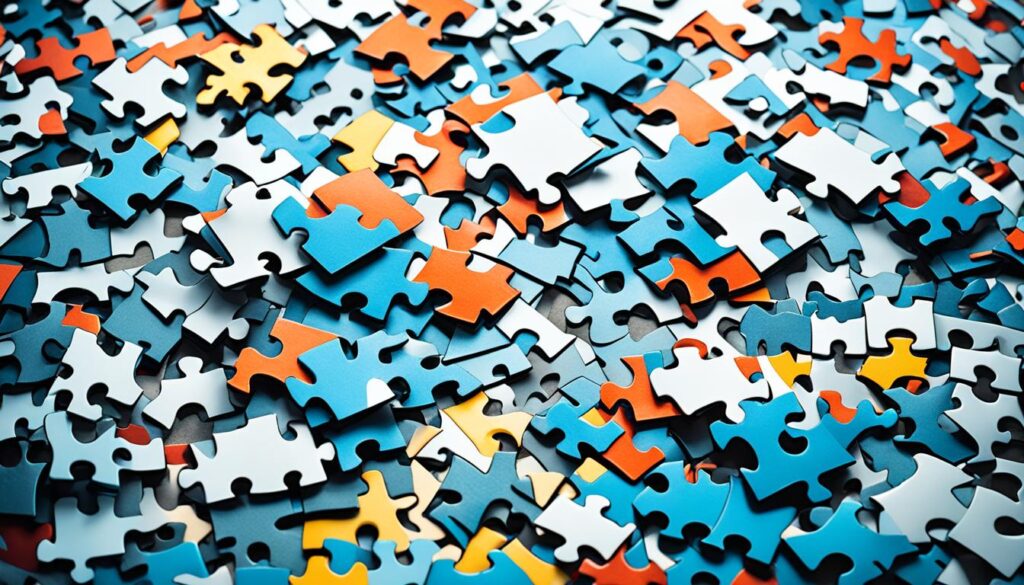The human mind is a complex and fascinating thing. It can store, retrieve, and recall a huge amount of information. Memory is key to our thinking and actions. It shapes our experiences and thoughts.
In this article, we’ll explore the science of memory. We’ll look at how we remember and forget things. We’ll also discuss ways to improve our memory in today’s tech-filled world.
Memory is complex, involving different stages and types of processing information. From the start, our brains work hard to encode sensory information. They store and retrieve memories using complex neural networks.
By understanding how memories are formed, stored, and retrieved, we can learn more about our minds. This knowledge can help us improve our memory and thinking skills.
Understanding the Basics of Memory
Memory is a complex process that involves the brain’s ability to encode, store, and retrieve information. It’s important to know the different types of memory and how the brain structures help form memories.
Types of Memory: Sensory, Short-Term, and Long-Term
There are three main types of memory: sensory, short-term, and long-term. Sensory memory records information from the senses for just a few seconds. Short-term memory holds information for 20-30 seconds and is used for immediate tasks. Long-term memory stores information for a long time, from minutes to a lifetime.
The Role of the Brain in Memory Formation
The brain’s structures, like the hippocampus and prefrontal cortex, are key in making and storing memories. The hippocampus helps encode and consolidate new memories. The prefrontal cortex is involved in retrieving and using stored information. These areas work together to help us learn, remember, and make decisions based on our past.
Understanding how memory works is key to improving our cognitive abilities. By exploring the different memory types and the brain’s role, we can see how complex and interesting the human mind is.
Encoding: The First Step in Memory
Memory is a complex process with several stages. The first step is encoding. This means turning information into a form the brain can store. It’s crucial because how well we encode information affects how well we can remember it later.
Strategies for Effective Encoding
Attention plays a big role in encoding. If we focus on information, we’re more likely to remember it. Concentration is also key. It helps us stay on task and ignore distractions.
Using mnemonics and visualization can boost our memory encoding. Mnemonics link new info to something familiar, like a rhyme or image. Visualization creates a vivid mental picture of the information, making it easier to recall.
By using these strategies, we can get better at encoding and remembering information. This is useful for remembering anything from a shopping list to a new phone number or an important presentation. Mastering encoding can greatly improve our memory.
Storage: Retaining Information in the Brain
Memory doesn’t stop after encoding. The brain must store information for later use. This process uses synaptic connections and neural plasticity.
Long-term memory is key to keeping information for a long time. It’s different from short-term memory, which forgets quickly. Long-term memory keeps our knowledge and experiences safe for years.
When we learn new things, our brain makes new paths and strengthens old ones. This is called neural plasticity. It’s how our brain changes to adapt to new info. The more we repeat or think about something, the stronger the connections between neurons get.
Memory consolidation is a vital step in storing information. The brain moves new info into our long-term memory network. This can take hours, days, or weeks, depending on the info’s complexity and importance.
Learning about memory storage helps us understand our brains better. It shows us how to keep information longer. Whether it’s for school, learning a new skill, or remembering a special moment, memory storage is crucial.
Retrieval: Accessing Stored Memories
The final step in the memory process is retrieving stored memories. Encoding and storage are key for making memories. But, it’s the retrieval stage that lets us use the information we’ve stored. Knowing what affects memory retrieval helps us improve our memory.
Factors Influencing Memory Retrieval
Being able to recall memories can be affected by cues or context. Memories are linked to specific times and places, emotions, or sensory details. When these cues are there during recall, they help us find the information we need.
The way we try to remember things also matters. Trying to recall information on our own is harder than just recognizing it. This is because recall makes the brain work harder to find the memory. Recognition is easier because it just matches new info to something we already know.
Other things can also affect how well we remember things. The age of the memory, how well it was stored, and interference from other memories can all play a part. Knowing these can help us find better ways to remember things.
The Forgetting Curve: Why We Forget
We all know it’s hard to remember important stuff. This is because of the forgetting curve, a fact that shows how we forget things over time. Knowing why we forget is key to keeping our memories sharp.
Causes of Forgetting: Decay, Interference, and Retrieval Failure
Several things affect the forgetting curve, like memory decay, interference, and retrieval failure. Memory decay means our brain’s connections weaken, making it tough to recall information. Interference happens when new info gets in the way of remembering old stuff, leading to confusion and forgetting. And retrieval failure is when we can’t find the info in our memory, even if it’s still there.
These factors combine to shape the forgetting curve. It’s important to know how they affect our memory. By understanding these causes, we can find ways to keep our memories strong over time.
Improving Memory Techniques
Improving our memory is a key skill that boosts our brain power and productivity. There are many techniques and strategies to make our memory better. Using mnemonic devices and memory aids are two great ways to do this.
Mnemonic Devices and Memory Aids
Mnemonic devices help us remember new info by linking it to something familiar or meaningful. For instance, “HOMES” can remind you of the Great Lakes (Huron, Ontario, Michigan, Erie, Superior). These strategies make remembering easier.
Memory aids are also great tools. They are things like calendars, to-do lists, apps, or objects that help us remember. Using these tools can make remembering easier and free up our brains for other tasks.
Practicing with mnemonic devices and memory aids can really pay off. These methods help you remember facts, names, and details better. They also boost your problem-solving skills and cognitive training.

If you’re a student or a professional, adding these memory techniques to your routine can change everything. Using mnemonic devices and memory aids can help you control your memory and reach your full mental potential.
The Impact of Technology on Memory
Technology has changed how we remember things in the digital age. Smartphones and social media have changed how we handle information. This change has good and bad sides that we should look at closely.
Technology has changed memory through cognitive offloading. We use devices to store and find information instead of remembering it ourselves. This can make our minds free for other things but might make us forget things we rely on devices for.
Also, the constant flow of information can make it hard to focus and remember new things. The fast pace of new technology adds to this problem. We have to keep up with new digital tools and platforms all the time.
But, technology can also help improve our memory. Tools like apps, virtual reality, and personalized learning platforms can make our memory better. By understanding how technology affects our memory, we can use it to make our minds work better in today’s world.
Age-Related Memory Changes
As we get older, our memory and thinking skills change. This part looks at how aging affects our memory and how to keep it strong. We’ll see how lifestyle, brain exercises, and other things help keep our brain and memory healthy.
Strategies for Maintaining Memory as We Age
Aging can make our memory and thinking slower, but we can fight this. Doing memory exercises and brain activities helps keep our memory sharp. Being active, eating right, and managing stress also help keep our brain and memory in good shape.
Trying new things that make us think can really help. Activities like learning a new skill, solving puzzles, or enjoying brain-stimulating hobbies are great. They make our brain connections stronger and help us remember better. Being social and staying active also boosts our memory and thinking skills as we age.
How much our memory changes with age can differ for everyone. Using a mix of these tips can lessen the effects of aging on our memory. By making brain-healthy habits part of our daily life, we can keep our thinking skills sharp and enjoy life more as we get older.
Memory Disorders and Diseases
Memory disorders and neurological diseases can greatly affect how we think and remember things. Alzheimer’s disease, dementia, and traumatic brain injury are some of the main ones. They can make it hard to remember new information or even things from the past.
Alzheimer’s disease is a condition that slowly gets worse over time. It mainly affects memory and thinking skills. People with it might forget recent events or have trouble solving problems and doing daily tasks. Dementia is a term that covers many symptoms, including memory loss, trouble with words, and changes in behavior.

Traumatic brain injury (TBI) can also cause big memory issues. This depends on how severe and where the injury is. People with TBI might find it hard to remember new things, get old memories back, or feel too tired to think clearly.
There’s no cure for these memory problems, but there are ways to help. Doctors might prescribe medicine, offer therapy, or suggest changes in lifestyle. Things like regular exercise and eating well can also help.
It’s important to know about the causes and effects of memory disorders. This helps in finding the right support and treatments. By keeping up with new research, people and doctors can work together to help those with these conditions.
The Future of Memory Research
Researchers are diving into new areas in memory research, thanks to neuroscience and technology. They aim to improve our memory and thinking skills. This could lead to big changes in how we remember things.
Emerging Technologies and Therapies
Artificial intelligence is changing how we study memory. It helps us understand how our brains store and find memories. By using AI, scientists learn more about the brain’s memory processes.
Brain-computer interfaces are also making waves. They let our brains talk to devices directly. This could lead to new treatments for memory problems, helping people with memory issues or those who are getting older.
New kinds of therapy are being tested too. Mindfulness-based therapies are showing promise. They help people focus better and remember things more clearly.
We can look forward to more of these new technologies and therapies. They will help us understand and improve our memory better.
Real-Life Applications of Memory Science
Memory science has many practical uses in our everyday lives. By learning how memory works, we can improve our learning, work, and thinking skills. This knowledge helps us do better in different areas.
In schools, memory science helps make studying more effective. Teachers use methods like spaced repetition and mnemonics to help students remember better. This leads to better grades and a deeper understanding of subjects.
At work, memory science makes us more efficient and helps us make better decisions. Workers can use techniques to remember important stuff, like deadlines and meetings. This means they can do more with less mistakes. Also, knowing how stress affects memory helps companies create better work environments.






